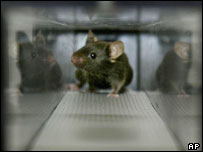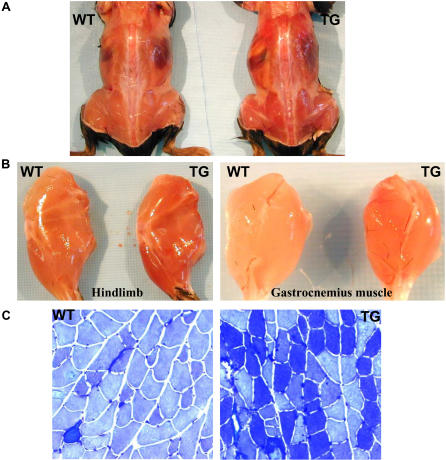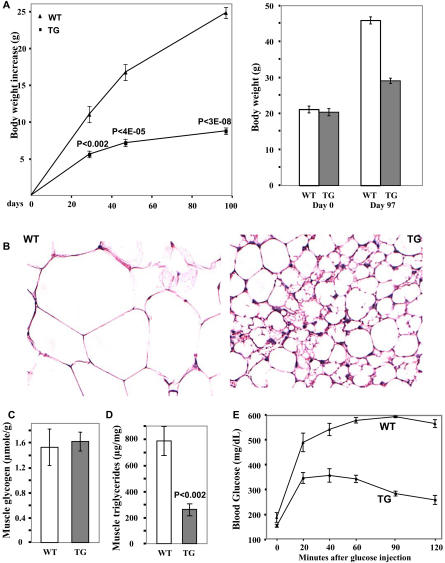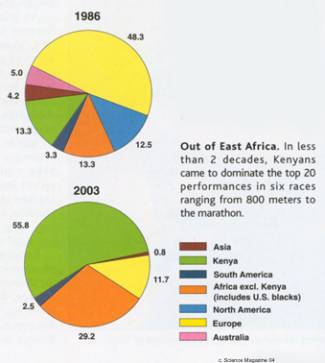This web page was produced as an assignment for an undergraduate course at Davidson College
The "Endurance Gene:" PPARδ
Background: Why do Kenyan runners dominate endurance running?

Ezekiel Kemboy, Brimin Kipruto and Paul Kipsiele Koech celebrate sweeping the 3000m Steeplechase for Kenya.
picture and caption taken from: http://www.iaaf.org/oly04/multimedia/type=photos/index,page=7.htmx
permission pending
|
Kenyans hold many running records, especially in distance racing. Kenyan men have won thirteen of the past fourteen Boston marathons. Kenyan women hold half of the top ten marathon times. Many of these runners come from the same small area in Africa, Kenya's rift valley. Is it something in the water? Does a lower oxygen level, at the relatively high altitude of the rift valley cause an increase in lung capacity and oxygen-use efficiency? Maybe it is a carbo-rich diet or the fact that many children grow-up running to and from school. This sports question has become a scientific one with the investigation of why so many good endurance runners are rift valley natives (Holden, 2004). |
|
Popular Press and "Marathon Mice"
cnn.com
A recent article released by CNN.com says that mice can now be genetically engineered to run farther and longer than naturally bred mice. The CNN article acknowledges the role such a genetic alteration could play in the arena of competitive sports. The engineered mice not only had so-called enhanced exercising ability, but were also able to resist weight gain, even while kept sedentary and fed a high-fat diet. Ronald Evens, who conducted some of the research that led to these observations, points out the practical implications of his research, which range from managing obesity to handling heart disease. This article addresses the "fat switch" gene, which creates "fatigue-resistant" muscles, when switched on. This article discusses the difference between "fast twitch" and "slow twitch" muscle, citing that sprinters' cultivation of "fast twitch" muscle is at the cost of endurance, while endurance runners build up "slow twitch" muscle. |

permission pending: http://www.cnn.com/2004/TECH/science/08/23/marathon.mice.ap/
|
news.bbc.co.uk
An international article, discusses the transition of a mouse to an "endurance athlete" when the gene controlling "slow-twitch" muscle fiber is altered. The article states that fast and slow twitch skeletal muscle fiber serve separate functions; slow-twitch muscle fiber is more fatigue-resistant than fast-twitch muscle fiber. The gene pparδ was cited as the altered gene and a master regulator of other genes. When PPARδ was enhanced, an increase in "slow-twitch" muscle fiber and a decrease in "fast-twitch" muscle fiber was observed. The fact that mice with extra PPARδ were able to run twice as far as the unaltered control mice leads researcher Ronald Evans and his colleagues to believe that the pparδ gene plays a role in endurance. Enhanced mice were also resistant to weight gain. Evens suggests that the reason for this resistance is due to the increased number of muscle fibers. The impact of such a metabolic mechanism, if able to be engineered in humans, would be of value to people who are overweight. Use by athletes and elite runners, especially endurance runners, would bring an ethical question to the issue. |
Scientific Article : Regulation of Muscle Fiber Type and Running Endurance by PPARδ
This article examines physiologic properties, such as fatigue and endurance, in mice, through molecular manipulation and analyation, . Experiments, conducted in this study targeted expression of an activated form of the gene: peroxisome proliferator-activated receptor delta (pparδ), in skeletal muscle (Wang et al, 2004). An over expression of PPARδ in skeletal muscle induced the formation of type I muscle fibers. The mice that were genetically altered were able to run greater distances than wild-type littermates. The incidence of obesity was lower in the genetically altered mice (Wang et al, 2004).
To make transgenic mice, transactivation domain VP16 was fused with the N-terminus of pparδ. This fused cDNA was then placed downstream of the human alpha-skeletal actin promoter and upstream of the SV40 intron/poly(A) sequence. Transgenic mice were bred by injecting C57BL/6J x CBA F1 zygotes with the gene and backcrossing C57BL/6J for two generations. Wild-type mice were used as controls. Mouse expressed sequence tag (EST) clones were used as probes in gene expression analysis and physiological studies. Previously generated null-PPARδ mice were used to compare incidence of obesity when mice were fed on diets containing either 35% (high) or 4% (low) fat. The exercise test was given in consecutive increments of 10 meters/minute, for the first 60 minutes, followed by 1 meter/minute increases, at 15 minute intervals, after the first 60 minutes. Exhaustion was defined by mice's inability to avoid repetitive electrical shocks.
Skeletal muscle fibers are classified as type I or type II. Type I fibers are oxidative and slow, with respect to metabolism and contraction, while type II are glycolytic and fast. Type I skeletal muscle is mitochondria-rich, uses mainly oxidative metabolism to produce a stable supply of ATP, and is generally acknowledged to be more fatigue-resistant. There are three subtypes of type II muscle fibers: IIa IIx and IIb. Contraction and metabolism of type IIa and IIx lye between type I fibers, which are mitochondria-rich, and type IIb fibers, which have the lowest mitochondrial content and oxidative enzyme concentrations; type two fibers rely on glycolytic metabolism and are susceptible to fatigue (Wang, 2004). Glycolysis is an anaerobic process. The aerobic, slow-twitch, pathway uses oxidative phosphorylation to produce ATP.
Previous studies have shown skeletal muscle to be dynamic, converting between type II, subtypes (Berchtold, 2000). Studies have been done investigating the relationship between type I fibers and obesity and diabetes, in rodents. These studies show a decreased percentage of type I fibers in obese and type 2 diabetic patients (Hickey et al., 1995). PPARδ is the predominant PPAR isoform found in skeletal muscle. PPARδ
is the first transcription factor able to drive the formation of functional type I muscle fibers. Activation of PPAR δ enhances physical performance and obesity resistance through complex pathways (Wang et al., 2004).

© 2004 Wang et al. |
Type I muscle fiber is distinguished from both type II and mixed muscle fiber, by its red color. This is due to a high concentration of myoglobin, a protein typically expressed in oxidative muscle fibers.
These figures show increased oxidative type I fibers in the transgenic mice (TG). Figures A and B show redder muscle fiber in TG mice, as compared to the WT mice. Figure C is a metachromatic staining. Type I fibers are stained dark blue and appear more abundant in TG.
|

© 2004 Wang et al. |
Previous studies have shown that obese individuals have fewer oxidative fibers. A testable hypothesis is that the presence of oxidative fibers may play a role in obesity resistance. The following results were obtained when body weights of transgenic mice were compared with wild-type mice after being fed a high fat diet.
Figure A shows that body weight increases more in the wild type than in the transgenic mice, after 97 days of ingesting a high-fat diet. Figure B is a histological analysis of inguinal fat pad showing smaller cell size in TG. Figures C, D and E examine the possibility of a different metabolic pathway existing in wild-type and transgenic mice. Figure C compares glycogen content. No significant difference between wild-type and transgenic mice is detected in figure C. Figure D shows a statistically significant difference between the triglyceride level in wild-type and transgenic mice. Glucose levels also appear to be statistically different between the two groups, in Figure E. |
Exercise performance was tested and compared in untrained transgenic mice and untrained wild-type littermates, with the same body weight. Running time sustained by transgenic mice was increased by 67% and distance was increased by 92%. The effect of the absence of of PPARδ
was also examined. PPARδ null mice were able to sustain only 38% of the time and 34% of the distance that wild-type mice ran.
To see a video of mice running during the exercise performance test, click here. The transgenic mouse is on your right and the wild-type mouse is on your left.
Conclusions
The scientific article is more detailed than the popular press articles. The scientific article explains experiments and presents data to a specific audience, while the popular press articles summarize a story, for the general public. Thus, the disparity between science and science in the news (Kua, 2004). It is perhaps important to note that there is a spectrum on which popular press articles are published, making some more scientifically newsworthy than others. Of the two cited popular press articles, one is more sensationalized and simplified, referring to the mice as "Schwarzenegger mice" and never mentioning the name of the "fat switch" gene, than the other article.
It appears, from the data presented in the scientific article, that the protein encoded by the pparδ gene has an effect on a mouse's level of type I muscle fiber and resistance to obesity. A greater amount of type I muscle fiber may correspond to greater endurance, through an oxidative phosphorylation metabolic pathway.
This article states, in the discussion that, "while induction of muscle oxidation enzymes by PPARδ has been seen both in vivo and in vitro, its effects shown here on muscle fiber switching are unexpected....This does not solely depend on achieving a directed muscle fiber switch but also requires all the associated changes in neuron innervation, motor neuron function, and peripheral metabolic adaptation to enable a new integrated physiological response" (Wang et al., 2004). This comment acknowledges that, just as one gene may play a role in more than one biological process or physiological phenotype, more than one gene may be responsible for any one of those observed phenomena.
References
"Marathon" Mice Engineered for Extra Endurance. CNN.com. August 23, 2004. <http://www.cnn.com/2004/TECH/science/08/23/marathon.mice.ap/> Accessed August 31, 2004.
"Marathon" Mouse Keeps on Running. August 24, 2004. <http://news.bbc.co.uk/1/hi/sci/tech/3592976.stm> Accessed August 31, 2004.
Berchtold et al. 2004. Calcium Ion in Skeletal Muscle: Its
Crucial Role for Muscle Function,
Plasticity, and Disease. Physiological Reviews. 80:1215-1265.
Hickey et al. 1995. Skeletal
muscle fiber composition is related to adiposity and in vitro glucose transport rate in humans.
Am J Physiol. 268:E453E457.
Holden, Constance. 2004. Peering Under the Hood of Africa's Runners. <http://www.jonentine.com/reviews/AAAS_peeringUnderTheHood.htm>Accessed September 1, 2004.
Kua et al. 2004. Science in the news: a study of reporting genomics. Public Understanding of Science. 13:309-322.
Wang et al. 2004. Regulation of Muscle Fiber Type and Running Endurance by PPARδ. Public Library of Science. August 24, 2004. <http://www.pubmedcentral.nih.gov/articlerender.fcgi?tool=pubmed&pubmedid=15328533> Accessed September 1, 2004.
Emily Wilson's Genomics Home Page
Davidson College Genomics
Davidson College Home

 permission pending: http://www.krsh.com/morningshow/blindedarchive/ExcellenceattheEdge.htm
permission pending: http://www.krsh.com/morningshow/blindedarchive/ExcellenceattheEdge.htm

